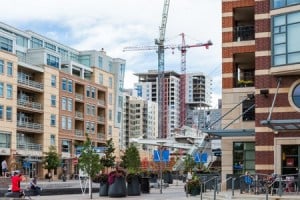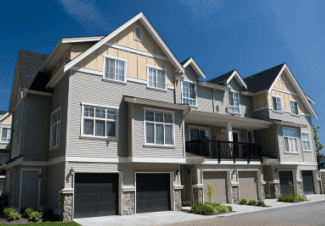Top Markets for Multifamily Development

Developers are planning to build a lot of new apartment units across the country. But they have not yet overwhelmed the supply pipeline in the markets they are most interested in.
“In the fullest sense, none of these markets are overbuilt,” says Andrew Rybczynski, senior consultant at research firm the Costar Group.
Population is growing quickly in all of the cities where developers are planning to build the most new apartments, according to CoStar data. In addition, development can be a long, slow process. In many of these cities, the number of apartments completed over the last year is much lower than the number of apartments that developers have announced they plan to build.
1. Miami
Building cranes still tower over downtown Miami—the busiest market in the U.S. for the planned development of multifamily housing. Immigration has kept the population of Miami growing, and that has kept developers busy planning new projects.
Miami is number one on CoStar’s list of markets with more than 50,000 units with the highest share of apartments under construction as a percentage of existing inventory.
Developers had 16,777 new units of multifamily housing in some phase of the development process in Miami in the third quarter of 2018, according to CoStar. That works out to 11.4 percent of the current inventory.
Research firm MPF counts 9,656 new rental apartments under construction in the Miami-Miami Beach-Kendell, Fla. metro area. (MPF only counts apartments that are physically under construction, instead of counting projects that have been announced, but may still be arranging their financing or building permits.) That’s equal to 3.3 percent of the inventory across the broader metro area.
2. Salt Lake City
Salt Lake City is friendly to business and relatively inexpensive compared to many cities. That has kept its economy strong, helping to make the city number two on CoStar’s list of top markets for new development.
Developers had 6,527 new units of multifamily housing in some phase of the development process in Salt Lake City in the third quarter of 2018, according to CoStar. That works out to 9.9 percent of the current inventory.
MPF counts 3,237 new rental apartments under construction in the Salt Lake City-Ogden-Clearfield, Utah metro area. That’s equal to 3.1 percent of the inventory across the broader metro area.
3. Nashville, Tenn.
Good schools, as well as jobs created by looser regulation and lower taxes, continue to draw new residents to Nashville, Tenn., says Rybczynski. The city is number three on CoStar’s list of top markets for new development.
Developers had 10,220 new units of multifamily housing in some phase of the development process in Nashville in the third quarter of 2018, according to CoStar. That works out to 8.7 percent of the current inventory.
MPF counts 5,329 new rental apartments under construction in the Nashville-Murfreesboro-Franklin metro area. That’s equal to 3.6 percent of the inventory across the broader metro area.
4. Boston
Smaller cities in the Southern and Western U.S. dominate CoStar’s list of top markets for new development, but there are a few exceptions.
“Boston is an exception here, as a tier one metro in the Northeast that is powered so much by education and biotech in Cambridge,” says Rybczynski, who put Boston at number four on his list of top markets for new development.
Developers had 17,707 new units of multifamily housing in some phase of the development process in Boston in the third quarter of 2018, according to CoStar. That works out to 8.6 percent of the current inventory.
But only a few of these planned apartments have actually broken ground. MPF counted far fewer new rental apartments under construction in the Boston metro area, equal to just 1.9 percent of the inventory across the broader metro area. The difference between MPF and CoStar shows how long it can take for a planned project to be approved by local officials and actually start construction.
5. Jacksonville, Fla.
Jacksonville, Fla. is number five on CoStar’s list of top markets for new development.
“Cities like Fort Lauderdale and Palm Beach and Jacksonville have made the list over the years partially based on cost, both for residents and for business that drive job growth,” says Rybczynski.
Developers had 6,906 new units of multifamily housing in some phase of the development process in Jacksonville, Fla. in the third quarter of 2018, according to CoStar. That works out to 8.2 percent of the current inventory.
MPF counts 3,988 new rental apartments under construction in the Jacksonville metro area. That’s equal to 3.5 percent of the inventory across the broader metro area.
6. Seattle
A booming tech economy has kept developers interested in building apartments in Seattle, perhaps too interested. “The volume of new supply has dampened rent growth,” says Greg Willett, chief economist with RealPage Inc., a provider of property management software and services.
Seattle is the only city on CoStar’s list of top cities for new development where rents fell over the year the ended in the third quarter on 2018. It is number five on CoStar’s list of top markets for new development.
Developers had 24,388 new units of multifamily housing in some phase of the development process in Seattle in the third quarter of 2018, according to CoStar. That works out to 7.7 percent of the current inventory.
MPF counts 15,986 new rental apartments under construction in the Seattle metro area. That’s equal to 4.8 percent of the inventory across the broader metro area, making it tie with Charlotte, N.C. for number three on MPF’s list of top markets for new construction.
7. Denver
Education is the chief driver of the strong demand for new apartments in Denver, which is number seven on CoStar’s list of top markets for new development.
Developers had 16,699 new units of multifamily housing in some phase of the development process in Denver in the third quarter of 2018, according to CoStar. That works out to 7.1 percent of the current inventory.
MPF counts 12,624 new rental apartments under construction in the Denver-Aurora-Lakewood metro area. That’s equal to 4.4 percent of the inventory across the broader metro area, making it number seven on MPF’s list of top markets for new construction.
8. East Bay, Calif.
Just across the Bay from San Francisco, developers are busy in towns like Oakland and Berkeley, Calif. The area is number eight on CoStar’s list of top markets for new development.
Developers had 11,632 new units of multifamily housing in some phase of the development process in the East Bay in the third quarter of 2018, according to CoStar. That works out to 7.0 percent of the current inventory.
MPF counts 6,936 new rental apartments under construction in the Oakland-Hayward-Berkeley metro area. That’s equal to 3.4 percent of the inventory across the metro area.
9. Charlotte, N.C.
Charlotte is number nine on CoStar’s list of top markets for new development.
Developers had 11,065 new units of multifamily housing in some phase of the development process in Charlotte in the third quarter of 2018, according to CoStar. That works out to 6.8 percent of the current inventory.
MPF counts 8,634 new rental apartments under construction in the Charlotte-Concord-Gastonia metro area. That’s equal to 4.8 percent of the inventory across the broader metro area, making it tied with Seattle for number three on MPF’s list of top markets for new construction.
10. Austin, Texas
Austin is number 10 on CoStar’s list of top markets for new development.
Developers had 13,991 new units of multifamily housing in some phase of the development process in Austin in the third quarter of 2018, according to CoStar. That works out to 6.7 percent of the current inventory.
MPF counts 10,282 new rental apartments under construction in the Austin-Round Rock metro area. That’s equal to 4.3 percent of the inventory across the broader metro area, making it number eight on MPF’s list of top markets for new construction.
Source: nreionline.com















 Accessibility
Accessibility